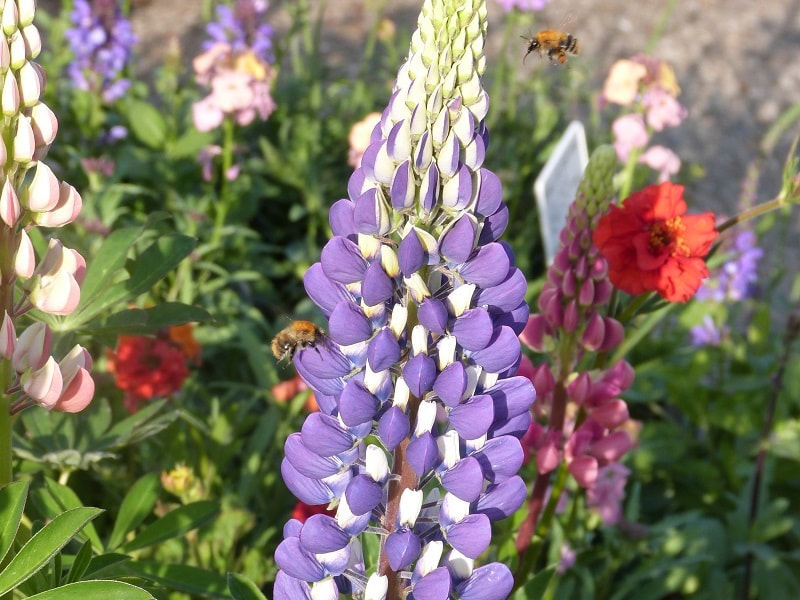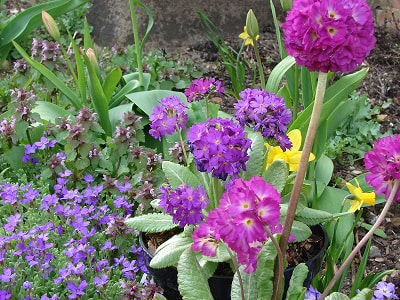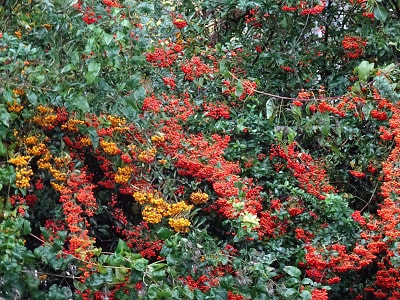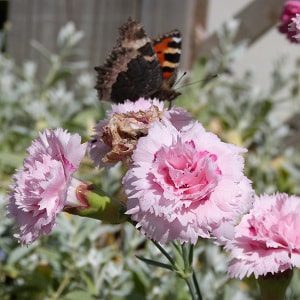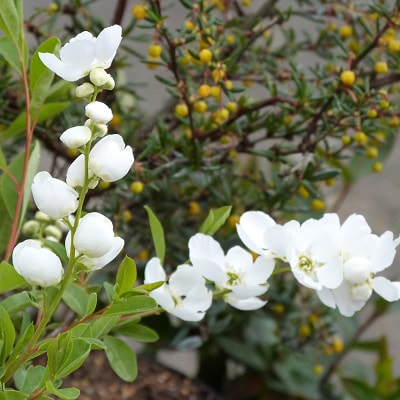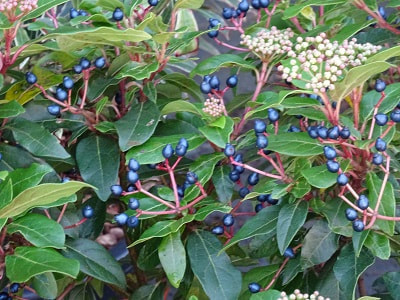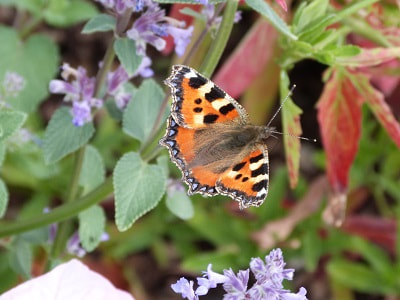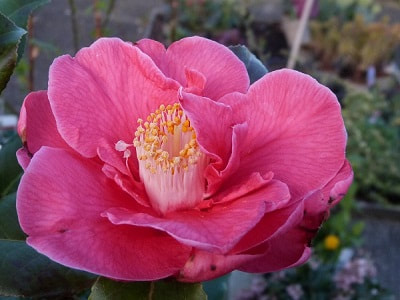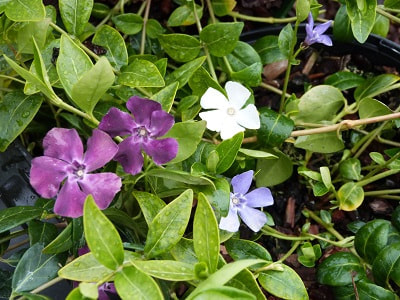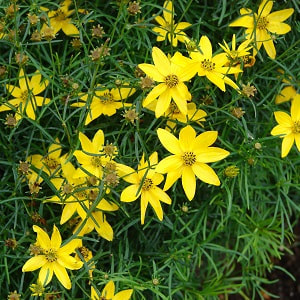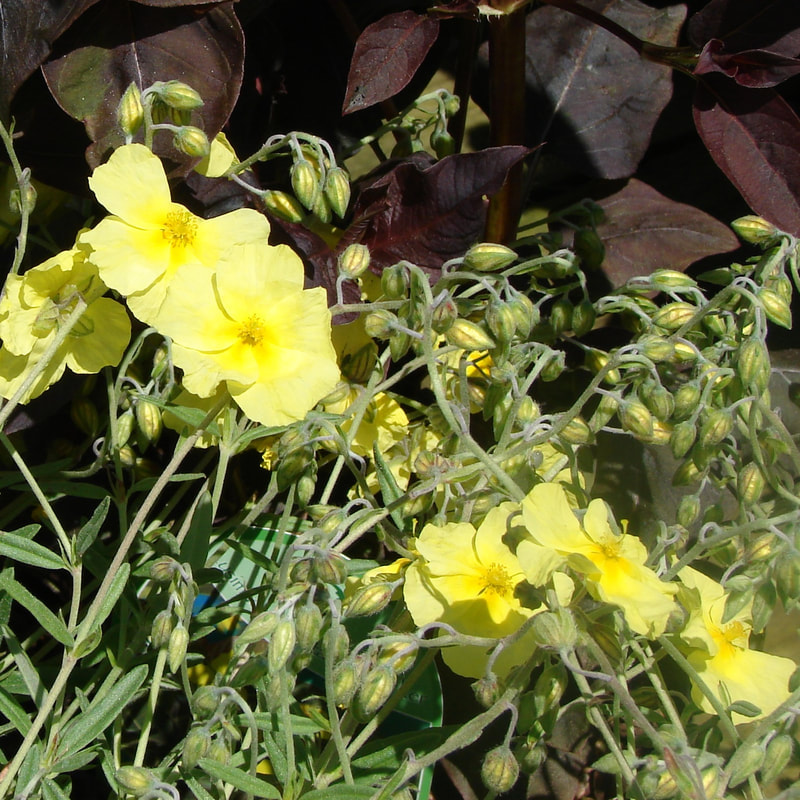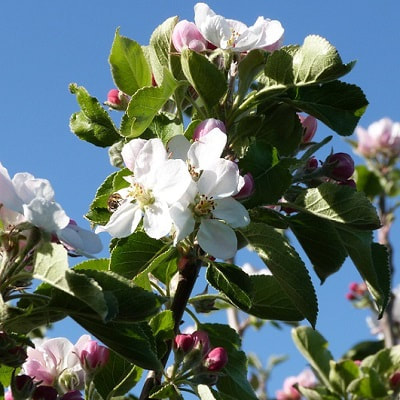Plant inspiration
Got a vision for the garden but not sure which plants you should choose?
Take a look through our Advice pages and Plant Collections below.
Shrubs can be planted in ones, although it can tie a garden together if the same shrubs appears more than once; we recommend perennials are planted in clumps of at least three. Again, if you are doing a large border, repetition is very effective.
Take a look through our Advice pages and Plant Collections below.
Shrubs can be planted in ones, although it can tie a garden together if the same shrubs appears more than once; we recommend perennials are planted in clumps of at least three. Again, if you are doing a large border, repetition is very effective.
Build-your-own Packs
Bee friendly
It would probably be shorter to write down which of our plants aren't bee-friendly than those that are. For now we are picking out some of our favourites from what we usually stock.
The RHS has a lengthy Plants for Pollinators list on their website to give you more ideas. Pictured: Agastache (giant hyssop), Allium, Apple tree, Ceanothus (california lilac), Centaurea Silver Feathers, Centranthus (valerian), Cynara (cardoon), Digitalis (foxglove), Lavender, Lupin, Origanum, Primula vulgaris (native primrose), Pulmonaria (lungwort), Salvias microphylla, nemerosa & ulignosa, Sedum, Verbena, Veronica Winter Interest
Any evergreen plant (those that keep their leaves year-round) will provide some structure and interest in your garden.
But other plants can really shine once they lose their leaves to reveal interesting stems :Cornus (dogwood) with colourful stems, as well as twisted willow (Salix tortuosa) and twisted hazel (Corylus contorta). For flowers in the cooler months, there are numerous options. Pansies, Violas and Bellis scattered through borders and in pots can give your garden a real lift at little cost. Fatsias, Skimmias, Viburnum tinus and Viburnum davidii are all evergreen shrubs with winter flowering periods, and all will grow in shade and sun to boot. Viburnums Charles Lamont and Dawn lose their leaves but make up for this with sweetly fragrant flowers at this time of year. More fragrance can be provided by Sarcococca (sweet box), Mahonias, and winter-flowering honeysuckle (Lonicera fragrantissima) shrubs. Clematis cirrhosa and winter-flowering Jasmine (nudiflorum) are in the climber range. Hesperantha (Kaffir Lily) are usually the last perennial of the year to come into flower, and don't forget good old Hellebores! Nippy Nectar
The choice is vast when it comes to bee-friendly plants for summertime, but make sure your garden also has something for those pollinators that are out and about in late autumn and early spring.
Pretty much anything winter-flowering is likely to be a good bet. Ivy and Clematis cirrhosa are pollinator-friendly climbers. For shrubs consider Mahonia, Viburnum tinus, Fatsia japonica and Sarcococca (sweet box). Although really a summer-flowering shrub, Hebes often throw out blooms in the colder months too. Winter-flowering heathers are a really great option that will be much-appreciated by the bees. Primroses and wallflowers can bloom before Christmas, but really come into their own in springtime. Early flowering bulbs such as Crocus also help get the year off to a good start (snowdrops will be available "in the green" early next year), along with Hellebores (Christmas Rose), and evergreen carpeting perennials Ajuga (bugle), Lamium (ornamental nettle), Pulmonaria (lungwort) and Vinca (periwinkle): modern varieties provide a nice long flowering period. The majority of alpines - best in full sun and well-drained soil - are early flowering, early sources of nectar too. Bird Feeders
Most of the plants on the Berry Nice list will provide tasty meals for our feathered friends. For those birds that feast on bugs, well, we hate to bring up the circle of life, but the Nippy Nectar selection will be very useful to them, as will ground cover plants - which provide places for creepy crawlies to live.
Don’t be hasty to cut back ornamental grasses and perennials in the autumn – many will be visited by the birds for their seedheads. Perennials with at least one of the above benefits include Achillea (yarrow), Aster, Centranthus (red valerian), Cynara (cardoon), Echinops (globe thistle), Cirsium (thistle), Geranium (cranesbill), Nepeta (catmint), Vinca (periwinkle), Verbena. As well as food, think about habitat too. Have a lawn area, and plant trees, hedges and vigorous climbers for nesting sites. For trees, top picks include Rowan (Sorbus), Crab Apple (Malus), Cotoneaster and Hawthorn (Crataegus); for climbers Honeysuckle (Lonicera) and Ivy (Hedera) – all of these will provide both sustenance and shelter. Ditto native hedging plants. The White Garden
A classic theme for a tasteful, restful look. If you have the space, plant shrubs for a succession of flowers through the year: Magnolia could be followed by Amelanchier lamarckii (juneberry), then bridal wreath (Spiraea arguta), Philadelphus (mock orange), and white Buddleias, Potentilla and Hydrangeas for late summer.
Evergreen shrubs to consider include Escallonia, Cistus (rock rose), and fragrant Osmanthus and Sarcococca. Set off the look with neutral green ferns, Buxus (common box), Garrya, Laurus (sweet bay) and Fatsia. Or take another tack with silver leaf shrubs, such as Convolvulus (silverbush) and Pittosporum. Azaleas and Rhododendrons would be easy-care options for planters. Vinca Colado (periwinkle) have really clear white flowers for ground cover. Other recommendations for ground cover include Erigeron (Mexican fleabane) and Cerastium tomentosum (snow in summer). Alba, Album and Albus are the Latin names for ‘white’ so anything in our availability lists with these in the name will be suitable; ‘snow’ is a giveaway to flower colour too. The Romantic Garden
We would suggest a soft pastel scheme of whites, pinks and lilacs, but most plants below are available in stronger tones. You are aiming for a soft, loose feel, with fragrance coming from many in the selection.
Pictured: Campanula (bellflower), Clematis, Dianthus (garden pink), Lavender, Nepeta (cat mint), Peony, Rose. Spring Flowers for Shade
Spring is when shady spots can look their best. Aquilegias come in a kaledoiscope of colours; Dicentra and Lamium come white or pink, whilst periwinkle (the 'minor' version is well-behaved!) are in a choice of white, violet or periwinkle.
Pictured: Aquilegia (granny's bonnet), Dicentra (bleeding heart), Lamium (dead nettle), Pulmonaria (lungwort), Vinca (periwinkle) The Fragrant Garden
Easily overlooked when planning your garden, scent will add another dimension to your enjoyment. Fragrant flowers are usually a sign that the plant is pollinator friendly too. You will find lots of familiar names in this category.
Pictures: Buddleia (butterfly bush), Coronilla (a wall shrub/climber), Dianthus (garden pink), Jasmine, Honeysuckle, Matthiola (perennial stock), Phlox, Philadelphus (mock orange), Rose, wallflowers |
Berry Nice
Most berrying plants are a great source of food for the birds when pickings are thin.
Get festive early with holly (Ilex) and ivy (Hedera). Another evergreen, Firethorn (Pyracantha), is great as a wall shrub. Some Cotoneaster can also be used for covering walls, whilst others are more suited to ground cover. We also have them available as trees. Hypericum (St John's Wort) is another easy-to-grow plant and new varieties have showy berries at this time of year, although showiest of all must be the Pernettya (Gaultheria)! Native spindle (Euonymus europaeus) didn't get the memo that pink and orange don't go together, but it is a striking effect! A lot of the plants in our hedging range are good choices too. In the case of the blackthorn you may well want the sloe berries for yourself if you are a gin lover! Less associated with berries are Parthenocissus (virginia creeper/boston ivy), Sarcococca (sweet box), Berberis, Mahonia and evergreen Viburnum. And maybe not so well known but well worth a look are Clerodendron and the strawberry tree (Arbutus). Note that you will often need a pair of plants that can pollinate each other in order to get berries, although there is a good chance there will be another plant close enough in the neighbourhood. Taking it Easy Down Under
An easy way to get a well co-ordinated garden is to pick plants that are native to the same area. And if you want plants with year-round interest that are also easy to care for ... step forward the Australasian collection.
Your shopping list should include flower arrangers' favourite Pittosporum (make sure you check ultimate height as there is a huge variation, with some varieties a modest 3ft, while others go to well over 10ft), strappy-leaved Cordylines (cabbage palms) and Phormiums, Hebes, Acacias and bottlebrush Callistemons. You will not get a classically floral look with this selection but there is still lots of colour and diversity from the leaves, and other than occasional tidy-ups there is no need for pruning. This option is best for sunny, sheltered gardens with well-drained soils. Butterfly friendly
The best-known butterfly-friendly plant is, with very good reason, Buddleia, aka the Butterfly Bush. We have lots of varieties to chose from this November, including the dwarf Buzz range.
Other shrubs that can attract them include Ceanothus (California lilac) Hebes, Hydrangeas and Lilacs (Syringa). Herbs are a good bet (although our selection is small at this time of year), as are blueberry bushes. Lots of perennials (plants that come back year after year) are beneficial to the butterflies, with a strong crossover with the meadow look (further down page). Deep breath: daisy-flowered Aster, Aster, Coreopsis (tickseed), Echinacea (coneflower), Erigeron (fleabane), Gaillardia (blanket flower) and Helenium (sneeze weed); pincushion Knautia, Scabiosa and Cephalaria; thistles Echinops and Eryngium. Eupatoriums are a really great plant for the butterflies. Other options include Achillea (yarrow), Lupin , Monarda (bee balm), Nepeta (catmint), Salvia, Sedum and Veronica. Having It All
Much requested are low-maintenance flowering plants that hold their leaves all year round. As a bonus, most of those below are happy to grow in pots.
In the perennial range we often have a wide choice of Heucheras - great for ground cover in shade or sun. Mostly grown for their colourful leaves, they also produce sprays of bee-friendly flowers in early summer. Other carpeting options include Erigeron (fleabane), Vinca (periwinkle) and most of our alpine range. Woody-stemmed Salvias have a very long flowering period, although note they won't look so luscious in the wintertime. For easy-care shrubs, get early colour from Camellias, Azaleas, Pieris and Rhodondendrons, and late colour from Skimmia and Viburnum tinus. If flowers are less of a priority take a look at Nandina (heavenly bamboo - not invasive) and plants in the Taking it Easy collection, including Pittosporum and Phormium. Conifers are often overlooked as an easy-care option, but they can provide a real variety of shapes, textures and colours and many do stay small! The Spring to Summer Transition
Many gardens experience a lull in flowering when the spring bulbs have finished and the summer perennials are still to show their faces. Bridge the gap with the following plants. Alliums can be dotted through the borders.
Pictured: Allium, Aquilegia (columbine), Dicentra (bleeding heart), Erysimum (shrubby wallflower), Euphorbia, Gladiolus. Wildflower Meadow Tribute
Growing a wildflower meadow is much harder than most people expect. Take the easy route with these cultivars that provide the wild, loose look and come back year after year. They are not native but are still pollinator-friendly.
Pictured: Achillea (yarrow), Centaurea (cornflower), Cirsium (thistle), Coreopsis (tickseed), Gaura, Lychnis (rose campion), Papaver (poppy), Tancetum (tansy). Mediterranean Tribute
The dry soils of east Suffolk lend themselves well to Mediterranean style gardens. Go for a limited number of varieties, with lots of repetition, including of shrubs. As a bonus, most plants in this category are evergreen and need nothing more than an annual trim after flowering. For pots, Pelargonium Attar of Roses will provide heavenly scent.
Pictured: Allium, Cistus (rock rose), Euphorbia, Gladioulus byzantinus, Helianthemum (dwarf rock rose), Lampranthus (a ground cover succulent, also suitable for planters), Lavenders, Rosemary, Santolina (cotton lavender), Stachys (lamb's ear), Attar of Roses The Cottage Garden
More is more when it comes to the cottage garden. You want it to look like the plants have seeded themselves, so go for lots of repetition. Colourful is traditional but you could put your twist on it by choosing a colour theme. Go for a mix of shapes and make sure you include lots of verticals, such as Foxgloves and Lupins. You will be looking at mostly perennials and annuals but the freer your hand the better.
Pictured: For sun or light shade: Aquilegia (columbine), Campanula (bellflower), Clematis, Dicentra (bleeding heart), Digitalis (foxglove), Phlox, Rose, Salvia Pictured: For full sun: Alcea (hollyhock), Centranthus (valerian), Delphinium, Echinops (globe thistle), Iris, Lupins, Matthiola (perennial stock), Nepeta (catmint), Apple tree
|
Hours
Every day: 10am-5pm
|
Telephone |
|
Newsletters |
Rewards club |













